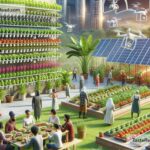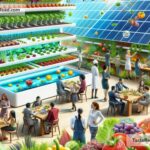The Future of Food and Regenerative Community Systems
Food is more than just something that fills our bellies; it connects us, shapes our health, and impacts the world around us. As we move into the future, it’s clear we need to rethink how we grow, share, and consume food. Climate change, environmental crises, and growing global populations have made our current methods of agriculture and food production unsustainable. But there is hope—a shift toward regenerative farming and community-focused systems could change the way the world eats for the better.
What’s the Problem with Today’s Food Systems?
Most of the food we eat comes from industrial agriculture, which focuses on growing as much food as possible, as quickly and cheaply as possible. But this has come at a steep cost. Industrial farming practices often depend on chemicals like pesticides and synthetic fertilizers that can harm soil, water, and wildlife. They also emit huge amounts of greenhouse gases, contributing to climate change. The heavy use of machinery and monoculture (planting only one type of crop) can deplete the land, leaving soil less fertile and vulnerable to erosion.
Add to that the challenges of food distribution. Tons of food are thrown away every year while millions of people go hungry in both developing and developed countries. This waste is not just bad for people—it’s harming the planet too, as discarded food often ends up in landfills, releasing methane gas that contributes to global warming.
Clearly, we need to change the way we produce and think about food. The good news? Solutions already exist, and they can be found in two big ideas: regenerative agriculture and community-based systems.
What Is Regenerative Agriculture?
Regenerative agriculture is like farming’s planet-friendly cousin. Instead of draining the land, it focuses on healing and restoring the environment. Farmers who practice regeneration work with nature rather than against it. This means using techniques that improve soil health, encourage biodiversity, and decrease chemical use. Let’s break that down:
-
Soil Health: Healthy soil acts like a sponge, holding more water and nutrients. It also captures carbon dioxide from the air, helping to fight climate change. Regenerative farmers use practices like cover cropping (planting extra crops to protect and nourish the soil) and reduced tilling to keep the ground fertile and strong.
-
Biodiversity: Regenerative farms often grow a mix of plants instead of monocultures. This diversity attracts insects and birds that naturally control pests and pollinate crops. Everyone wins—farmers need fewer pesticides, and ecosystems thrive.
-
Working with Nature: Some farms bring animals back into their fields to graze and fertilize naturally, while others use methods like agroforestry (growing trees alongside crops) to mimic healthy ecosystems.
Regenerative farming isn’t just a trend; it’s a solution that could make farming sustainable for generations to come.
Why Community Systems Are Key
While farming is important, food isn’t just grown—it’s shared. Communities everywhere are realizing that the way we connect over food can create stronger, healthier neighborhoods while helping the planet. Imagine local systems where food is grown, distributed, and consumed in a way that supports people and the environment, all at the same time.
Here are some examples of community-based solutions:
-
Urban Farming: Cities often seem far removed from agriculture, but urban farms are popping up to bring food production closer to home. Rooftop gardens, vertical farms, and community plots can grow fresh produce for local markets, reducing transportation emissions and making healthy food more accessible.
-
Food Cooperatives and Sharing Networks: In some communities, people are banding together to solve food challenges. Food cooperatives, for example, are grocery stores owned and operated by the people who shop there. They prioritize local, sustainable products. Sharing networks also include programs to distribute surplus food, ensuring that nothing goes to waste.
-
Community-Supported Agriculture (CSA): This is a special relationship between farmers and their neighbors. Families sign up to receive regular deliveries of fresh food directly from local farms. CSA programs support farmers, reduce environmental costs, and connect people to the source of their meals.
-
Education and Empowerment: Communities that understand food production can become more resilient. School gardens, cooking classes, and workshops teach people how to grow and prepare food sustainably, breaking down the divide between consumers and food producers.
How Technology Can Help
Technology is playing an exciting role in the future of food. Precision agriculture tools help farmers use resources like water and fertilizer more efficiently, while drones can monitor crop health. Vertical farming uses advanced lighting and automation to grow food indoors with almost no water or space waste. Apps and platforms are also enabling people to connect with local farmers, track food waste, or join cooperative systems.
A Future Full of Possibilities
The future of food isn’t just about what we eat—it’s about how food systems can regenerate the earth and bring people together. Regenerative agriculture restores land and reduces climate impact. Local networks and community-focused solutions ensure food reaches everyone while strengthening connections between neighbors. Technology plays a role in making these systems smarter and more efficient.
As more people embrace regenerative practices and community-based food systems, we have a real chance to make our planet healthier and fairer. The food of the future may not just fill stomachs—it may heal soil, replenish ecosystems, and unite communities. Now is the time to grow a system that works for everyone—people, planet, and future generations.


